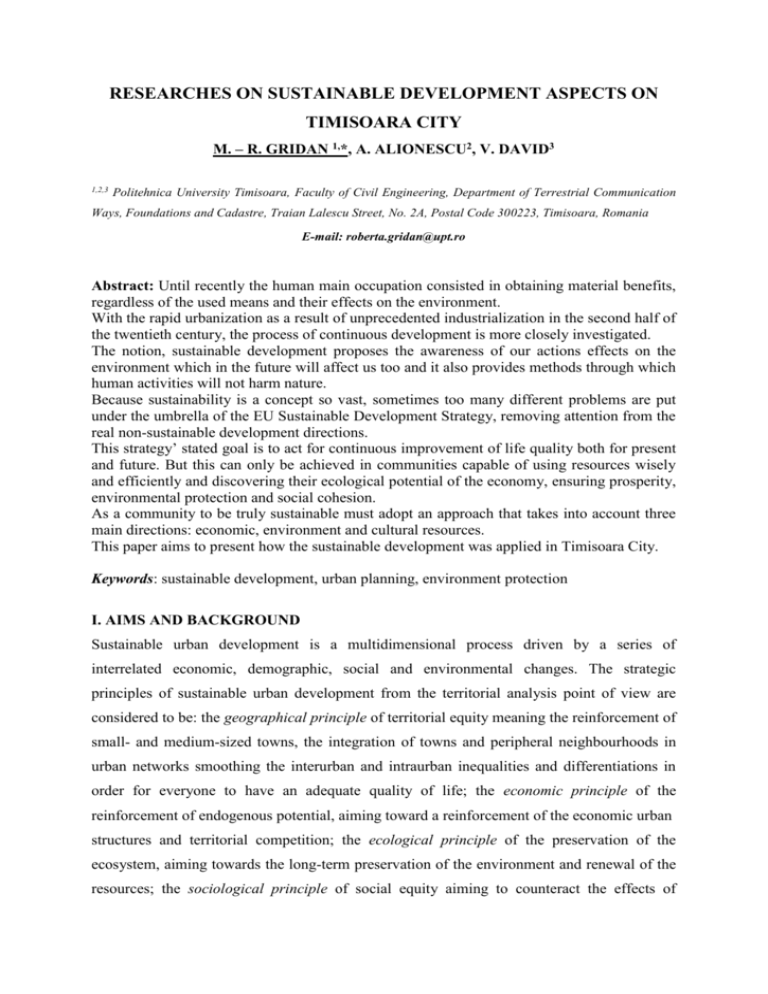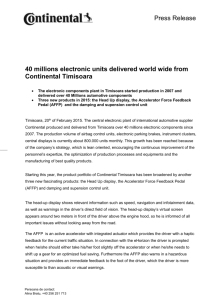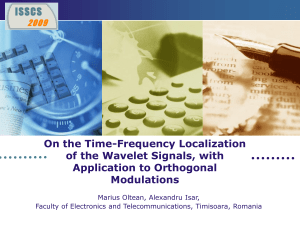Researches on sustainable development aspects on Timisoara city
advertisement

RESEARCHES ON SUSTAINABLE DEVELOPMENT ASPECTS ON TIMISOARA CITY M. – R. GRIDAN 1,*, A. ALIONESCU2, V. DAVID3 1,2,3 Politehnica University Timisoara, Faculty of Civil Engineering, Department of Terrestrial Communication Ways, Foundations and Cadastre, Traian Lalescu Street, No. 2A, Postal Code 300223, Timisoara, Romania E-mail: roberta.gridan@upt.ro Abstract: Until recently the human main occupation consisted in obtaining material benefits, regardless of the used means and their effects on the environment. With the rapid urbanization as a result of unprecedented industrialization in the second half of the twentieth century, the process of continuous development is more closely investigated. The notion, sustainable development proposes the awareness of our actions effects on the environment which in the future will affect us too and it also provides methods through which human activities will not harm nature. Because sustainability is a concept so vast, sometimes too many different problems are put under the umbrella of the EU Sustainable Development Strategy, removing attention from the real non-sustainable development directions. This strategy’ stated goal is to act for continuous improvement of life quality both for present and future. But this can only be achieved in communities capable of using resources wisely and efficiently and discovering their ecological potential of the economy, ensuring prosperity, environmental protection and social cohesion. As a community to be truly sustainable must adopt an approach that takes into account three main directions: economic, environment and cultural resources. This paper aims to present how the sustainable development was applied in Timisoara City. Keywords: sustainable development, urban planning, environment protection I. AIMS AND BACKGROUND Sustainable urban development is a multidimensional process driven by a series of interrelated economic, demographic, social and environmental changes. The strategic principles of sustainable urban development from the territorial analysis point of view are considered to be: the geographical principle of territorial equity meaning the reinforcement of small- and medium-sized towns, the integration of towns and peripheral neighbourhoods in urban networks smoothing the interurban and intraurban inequalities and differentiations in order for everyone to have an adequate quality of life; the economic principle of the reinforcement of endogenous potential, aiming toward a reinforcement of the economic urban structures and territorial competition; the ecological principle of the preservation of the ecosystem, aiming towards the long-term preservation of the environment and renewal of the resources; the sociological principle of social equity aiming to counteract the effects of poverty and social exclusion in urban areas; the political principle of territorial autonomy aiming to give more space to the decentralisation in decision-making related to urban developments1. Throughout history, the most important city from western Romania, Timisoara, passed through many phases of urban development. During the communist period the city suffered a lot of transformations specific to those times: the lost of many historical buildings. In the context of the candidacy to the "European Cultural Capital", the urban future plans must take into account both the historical aspect and the requirements of a 21th century city. The following paper aims to highlight the urban development of Timisoara City, from its first official mention to the present time. Also, there are presented the city' development directions and visions for the next years. II. RESULTS AND DISCUSSION Timisoara City the current residence of Timis County, documentary attested for over 730 years, is situated in Timis Plain. This plain is crossed by Bega and Timis rivers, which presence influenced the development of the locality from the fortified citadel with strongholds, water ditches and earth waves to nowadays city. At the last census, in 2011, Timisoara had a population of 319279 people, with a density of 2622 inhabitants/sqrm. The city on Bega River is twinned with important European cities like: Faenza, Gera, Karlsruhe, Mulhouse, Rueil-Malmaison, Szeged, Treviso, Palermo and Novi Sad2. Throughout history the city had several names: Zambara, Tibiscum, Beguey, Temesiensis, Temesvár, Temeschburg and Timišvár. The first human known presence, on the territory of today Timisoara city, dates back to the Neolithic period, more than 6000 years ago. The hearth geographic position on which Timisoara developed was near the centre of an area delineated by three important routes (the rivers Mures, Tisa and Danube) and with the fertility of the plane, the river meadows and the swamps provided the favourable food and living conditions for humans. Being situated in a strategic point from which can be controlled a large part of the Banat Plain, both Timisoara and Timis commit function are becoming increasingly important. Timisoara received a boost especially during the reign of King Charles Robert of Anjou, which ordered the construction of a Royal Palace, on the site where now is the Huniade Castle, built by John Hunyadi. The Royal Palace was built with Italian craftsmen in eight years, and it formed two rectangles, with their sides directed toward the four cardinal points, they were connected by a wooden bridge and a fortified tower. During 1316-1325, the capital of the Hungarian Kingdom will be moved to this city. The establishment of the Royal Court in this place led to the settlement population increase and the city became an important politic and commercial centre. On 26th July 1552, after long battles against the Turks, the commander Losoncius surrendered, with the condition that the troops leave the citadel freely, but the Turks didn't keep their word and killed all who came out. They realized the strategic importance of the city so they repaired and improved its defensive walls. In addition to the surrounding swamps which served as natural fortifications, the Turks raised stiffenings, oak palisander and dig deep trenches around Timisoara. The citadel' castle, the Huniade Palace served as home for the pasha. Fig. 1. Timisoara during the first otoman period3 After the victory against the ottoman armies from Petrovaradin (5th of August 1716), the Prince Eugene of Savoy decided to size the Timisoara citadel because of its important strategic position. So, on 12th October 1716, after a siege of 48 days with repeated bombing, that destroyed a large part of the buildings within the city, Mehmed Pasha, the last commander of Timisoara, accepted to surrender and the Turkish garrison left the town to withdraw south of the Danube. Fig. 2. Timisoara during the XVIIIth Century3 During the XVIIIth Century Claudius Mercy Governor created the first modern city by swamp draining, channeling the Bega river, encouraging the agriculture and founded a flourishing industry in a newly created district: The Fabric District. Also, a series of new modern edifices (like the Old Prefecture - the Baroque Palace today, the Romano - Catholic Dome, the City Hall, the first tipography, etc.) were built in this period and new districts developed arround the citadel: the Elisabetin and Iosefin districts. In the second part of the XIXth Cetury an avalanche of technical innovations revolutionized the urban life of Timisoara: - the telegraphy is inserted into town in 1853; - in 1857 Timisoara is the first city from Romania with public illuminating on gas and in the same year the city is connected to the European railway network; - the horse-drawn tram is introduced in 1867; - in 1881 the modern telephone network is installed; - Timisoara is the first European city with electric illuminated streets in 1884; - in 1895 started the street asphalting; - the electric tram was introduced in 18994. Fig. 3. Timisoara during the second half of the XIXth Century5 The first urbanistic plan was drawn up by the acrhitect Ybl. Throgh this plan the citadel beacome the center of the city and was linked with the near districts (Mehala, Iosefin, Elisabetin and Fabric) through large boulevards and a ring road around the Citadel. So, starting from the dense rectagular road network from the citadel a radial street structure is forshadowed. The terrain between the streets was divided into plots and the polts were sold to the population. Also this first urbanistic plan stipulated the citiy’ extension with 1800ha. Between 1901 – 1903 the first topographical surveys were made, using mathematical methods, for Iosefin and Citadel districts and in 1911 for Mehala district. In 1942 – 1946 the engineer I. Sarmes reasambled the cadastral plans for all the districts. Fig. 4. Timisoara during the first half of the XXth Century6 After the second World War, in 1951 the architects M. Silianu and G. Stork created a new urbanistic plan named “The Major Systematization Plan” with zooning and trafic stipulations, but the profile and scale of industrial development and housing were not anticipated. Along with industrialisation, choosing economic factors over ecologic ones, the pollutioncaused problems to emerge7. In 1959 the city had 148600 inhabitants and an area of 4100 ha. Without clear elements of forecasting the development of city functions, for 1980 was expected a population of 250000 inhabitants, which, according to some specialists, was considered too high. In 1980 were officialy registered in Timisoara 287543 inhabitants, and in 1990 were 354345 inhabitants2. In the communist period the industry developed very much and as a consequence the housings was strongly developed in blocks with detrimental effects to the urban city: a major part of areas with monofamilial households were destroyed. A major concept, politically imposed, was to increase the construction density which reflected in continuous reductions of the construction perimeter, so, in 1989 the buildable area was about 4558ha and in January 1990 it was 4974,32 ha. Nowadays, Timisoara is a modern European city which is continously developing from urbanistic point of view. Fig. 5. Timisoara today8,2 In the last years the investitions for renovating the historical buildings increased, for exapmle presently, extensive works for the historical center amenagement are ongoing. Therfore the Union Square (one of the squares from the old citadel) will retain the current configuration, but more novelty items will appear: in the area situated in front of the Baroque Palace will apear armchairbanks, which were kept in the museum since the ‘80s. After the works finalizing the local authorities announced new regulations for the operation of terraces and organizing cultural events in the Union Square (Fig. 5). III. CONCLUSIONS The problem of town planning represents a very complex activity regarding interdisciplinary interest for technical, economical and social development improvement, being able to provide accurate and efficient solutions in order to cover basic needs of land administrative information and decision-making for the local authorities9. Timisoara City had had a history of different influences in terms of architectural point of wiew and an particular urban development from the Middle Ages to the present. Fig. 6. Timisoara’s urban evolution2 Although Timişoara has gone through massive changes from urbanistic point of view in the Communist era, they have not totally destroyed the architectural heritage of the city, which was once the an imperial capital. In recent years, Timisoara has experienced different coloring schemes, generally chosen by owners or architects, without an unified approach, whether we speak about the case of blocks thermal rehabilitation or incorrect interventions on historic buildings. The environmental, the economic and social dimensions interfere the hardest inside the urban area10. The final goal of any correct and coherent sustainable development strategy is the inhabitants continuous life quality increase. Therefore, in order that Timisoara will become an European Cultural Capital, it must preserve an architectural and urban identity and is necessary for projects like the one on the buldings color must be implemented. It is also necessary that new constructed buildings, especially the ones in neighborhoods of great architectural importance to fit certain arhitecural patterns, which unfortunately isn’t the case today. ACKNOWLEDGEMENT: This paper is supported by the Sectoral Operational Programme Human Resources Development POSDRU/159/1.5/S/137516 financed from the European Social Fund and by the Romanian Government. IV. REFFERENCES 1. M. K. Karaguni: Sustainable Urban Development and Survival Challenge, J. Environ. Prot. Ecol., Vol. 14, No 4, pag 1719-1727 (2013) 2. www.primariatm.ro 3. www.art-historia.blogspot.ro 4. Timisoara City Hall Gazette, No. 91, pag 16, 2010 5. www.banaterra.eu 6. www.cartofilie.ro 7. R. Radoslav, A.-M. Branea , B. Demetrescu: Resolving Ecological Problems Through A Holistic Vision of Regional Urban Planning, J. Environ. Prot. Ecol., Vol. 13, No 4, pag. 2249–2256 (2012) 8. Where To Go 2010 Magazine, pag 6-17, 2012; 9. C. Greceaa, I. Ienciu, L. Dimen, A. C. Bala, L. Oprea: Cadastral Support for an Efficient Town Planning in Timisoara, Romania, J. Environ. Prot. Ecol., Vol. 13, No 2A, pag. 1099– 1106 (2012) 10. M. Mazilu: Urban Planning and Transportation Meeting Ecological Purposes, J. Environ. Prot. Ecol., Vol. 13, No 4, 2267-2272 (2012) 11. www.destinatiituristice.ro 12. www.cazare-timisoara.info CAPTION OF FIGURES Fig. 1. Timisoara during the first otoman period Fig. 2. Timisoara during the XVIIIth Century Fig. 3. Timisoara during the second half of the XIXth Century Fig. 4. Timisoara during the first half of the XXth Century Fig. 5. Timisoara today Fig. 6. Timisoara’s urban evolution Fig. 1. Timisoara during the first otoman period Fig. 2. Timisoara during the XVIIIth Century Fig. 3. Timisoara during the second half of the XIXth Century Fig. 4. Timisoara during the first half of the XXth Century Fig. 5. Timisoara today Fig. 6. Timisoara’s urban evolution






